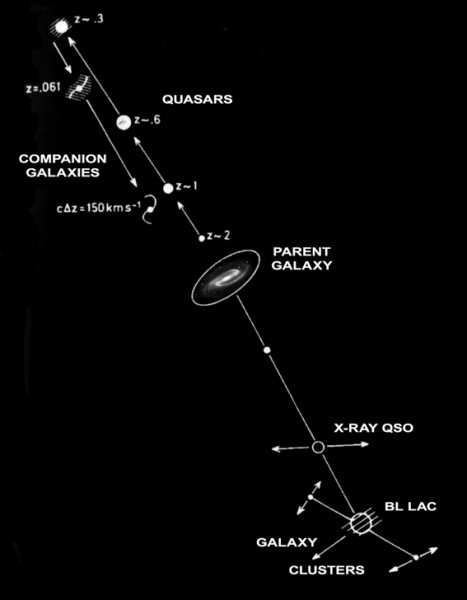holoscience.com | The ELECTRIC UNIVERSE®
A sound cosmology for the 21st century
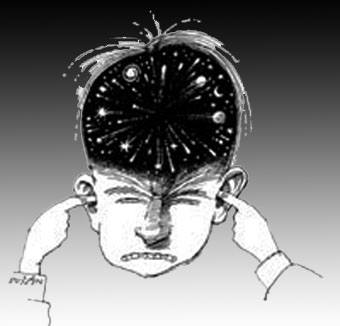
Cosmology in Crisis—Again!
“Nothing comes from nothing. Nothing ever could.”
—from The Sound of Music.

It seems the toughest thing for scientists to grasp—that a cherished paradigm like the big bang can be wrong. The latest crisis was reported in Physorg.com on May 5th: “Study plunges standard Theory of Cosmology into Crisis.” The study of dwarf companion galaxies of the Milky Way support the view that a “modified Newton dynamic” [MOND] must be adopted. “This conclusion has far-reaching consequences for fundamental physics in general, and also for cosmological theories.” One of the researchers involved said, “it is conceivable that we have completely failed to comprehend the actual physics underlying the force of gravity.”
In my news of April 21st I wrote, “we are so far from understanding gravity that we don’t know the right questions to ask.” There I proposed “Electrically Modified Newtonian Dynamics,” or “E-MOND,” as the solution for solar system stability. However, the problem involving the dwarf companion galaxies is more fundamental to cosmology. The first problem in physics is to choose the correct concepts to apply to our observations. That determines which physical laws to apply. But that’s not the end of it. We must remain aware that all laws are man-made and provisional—they are subject to modification on appeal. Historically, cosmologists have denied that electricity has any relevance in space. They have refused to consider how the laws of plasma physics might apply to their otherwise incomprehensible observations. Provisionality is a formalism to mask dogma.
Richard Feynman, lecturing his students on how to look for a new law in physics, said,
“First you guess. Don’t laugh; this is the most important step. Then you compute the consequences. Compare the consequences to experience. If it disagrees with experience, the guess is wrong. In that simple statement is the key to science. It doesn’t matter how beautiful your guess is or how smart you are or what your name is. If it disagrees with experience, it’s wrong. That’s all there is to it.”
Sounds simple? Perhaps that is why we see so many proposals for new laws of physics in the mad scramble for a Nobel Prize. But the emphasis is all wrong. It encourages wild guesswork and burgeoning complexity. Complexity facilitates endless “twiddling of knobs” to match new “experience.” Theories become practically unfalsifiable and unscientific—as witness, “string theory.” Underlying the guesswork in cosmology is the paradigm of the big bang. A paradigm is a system of belief that tends to be taken completely for granted. The guesswork is limited to modifications that don’t disturb the conviction. Questioning the established paradigm is resisted. The case of “the modern Galileo,” Halton Arp, is a classic example where the big bang “disagrees with experience” —and the experience is declared to be wrong. Feynman could usefully have added that it doesn’t matter how many people believe a theory, “If it disagrees with experience, it’s wrong. That’s all there is to it.”
Cosmology is in crisis because from the very outset the “big bang” was not science! The big bang invokes a miraculous creation of the universe from nothing. It is a misguided attempt to manufacture a creation story to complement, or compete with, the biblical Genesis story. But real science doesn’t do miracles. There was no contest anyway. The biblical creation story, like those of all other ancient cultures on Earth, has nothing to do with the creation of the universe. To believe so is to misunderstand the ancient meanings of “heaven” and “earth.”
A scientific, forensic investigation of mankind’s earliest ideas about heaven and earth show that “heaven” was the arena of the planetary “gods,” whose behavior was fearfully witnessed by our prehistoric ancestors in a catastrophic period of awful electrical splendor in the skies.

The spectacle motivated prehistoric humans globally to carve and paint rock faces with similar enigmatic representations (petroglyphs and rock art) of what has only recently been identified as ultra-high-energy auroral type displays. Our forebears were recording something unimagined today—the distinctive evolution of plasmoid “thunderbolts” hurled between celestial bodies on unusual cometary orbits. Plasmoids followed the Earth’s magnetic field lines to the magnetic poles. The “earth” was originally the magnificent auroral-type display “created” in the heavens. The antics of the capricious “gods” were remembered and memorialized by the first civilizations in their prodigious building works to recreate the “kingdom of heaven” on today what we call the Earth. Thunderbolts of the Gods describes this first scientific documentation of the origin of global themes in myths and religions. It introduces the real cosmology of The ELECTRIC UNIVERSE®. Only a REAL COSMOLOGY can reunite the fragmented sciences and provide a clearer human perspective of the universe.
The Big Bang—One Crisis After Another

A pioneer of plasma cosmology and the ELECTRIC UNIVERSE®, Hannes Alfvén, in his Nobel Prize acceptance speech in 1970, warned of a looming crisis in cosmology due to the ignorance of theoretical physicists about the real behavior of plasma in space. That crisis remains as a long-dormant infection waiting to cripple its host. The symptoms can be seen in attempts to explain auroras and solar activity in terms of unreal magnetic effects (“snapping” and “reconnection” of field lines—try to imagine snapping and reconnecting the lines of latitude or longitude!) and with no clear idea of how the magnetic fields are caused. But any high school student knows that electric currents generate magnetic fields. So magnetic fields in space are an effect of electric currents, not a cause. It seems that graduate physics training skips practicalities and commonsense and focuses on mathematical theorizing and the virtual-reality world of computer modeling. Alfvén was first and foremost a practical electrical engineer.
There are many other crises to be acknowledged by cosmologists.
In 1929 Hubble and Humason formulated the apparent redshift-distance relation of galaxies in deep space. In the metaphysics of Einstein, an expanding space seemed like it might explain the observations. But as an observer, Hubble remained more clear-minded:
“The assumption that red shifts are not velocity shifts but represent some hitherto unknown principle operating in space between the nebulae leads to a very simple, consistent picture of a universe so vast that the observable region must be regarded as an insignificant sample.” 1
Mathematical theorists eschewed simplicity and commonsense by assuming that the redshift was due to the Doppler effect and employing Einstein’s metaphysics so they could retrocalculate the seeming expansion back to a primordial point, or singularity—which has no physical reality. Score: mathematics-1; physics-0. But there is another simple option, unmentioned by Hubble, that instead of some “unknown principle operating in space between the nebulae” there is an intrinsic electric principle responsible for both the redshift and the faintness of a galaxy or quasar.
Recently supernovae in highly redshifted objects have been found to be fainter than expected. Big bang theorists surmised that the expansion of the universe must be accelerating. The response to this discovery was to invent yet another mysterious fudge factor for the unscientific big bang scenario — “dark energy.” This follows a tradition established with the conjuring up of invisible “dark matter” where needed to save the Newtonian dynamical model of spiral galaxy rotation. Rather than becoming clearer and simpler, big bang cosmology demonstrates “wild guesswork and burgeoning complexity” with each new discovery.
It is clear that both faintness and redshift are related to a lower intrinsic energy of quasars, galaxies, and the supernovae they contain. I have shown earlier that supernovae are an electrical discharge phenomenon. Neither redshifts nor supernovae can be used as a standard to measure intergalactic distances. If proof were needed for this commonsense assessment, the distinguished astronomer Halton Arp has shown repeatedly that highly redshifted quasars are born from nearby, low-redshift galaxies. The redshift of quasars is a measure of their youthfulness! Because of quasars’ physical and statistical connections with nearby galaxies, the faintness of highly redshifted quasars cannot be attributed to distance. Even more compelling is the discovery that intrinsic redshift takes discrete (quantized) values, which proves that the redshift is related to the matter in the quasar and not a measure of speed of recession or some effect upon light in traversing the intervening space.
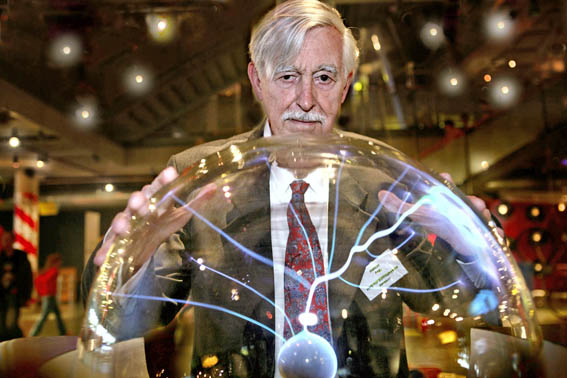
It seems the hardest thing for a scientist to grasp that a cherished consensus belief, perhaps one that is decades or a century old, can be wrong. Following is an excerpt from a report of the most recent crisis in cosmology. It calls into question both the existence of dark matter and our concept of gravity. The bell tolls loudly for the big bang!
Study plunges standard Theory of Cosmology into Crisis
[physorg.com] May 5th, 2009
As modern cosmologists rely more and more on the ominous “dark matter” to explain otherwise inexplicable observations, much effort has gone into the detection of this mysterious substance in the last two decades, yet no direct proof could be found that it actually exists. Even if it does exist, dark matter would be unable to reconcile all the current discrepancies between actual measurements and predictions based on theoretical models. Hence the number of physicists questioning the existence of dark matter has been increasing for some time now.
Competing theories of gravitation have already been developed which are independent of this construction. Their only problem is that they conflict with Newton’s theory of gravitation.
“Maybe Newton was indeed wrong,” declares Professor Dr. Pavel Kroupa of Bonn University’s Argelander-Institut für Astronomie (AIfA). “Although his theory does, in fact, describe the everyday effects of gravity on Earth, things we can see and measure, it is conceivable that we have completely failed to comprehend the actual physics underlying the force of gravity.”
Comment: Newton himself had the sense not to propose “the actual physics underlying the force of gravity.” All he did was to provide a mathematical expression describing the mysterious instantaneous tension between all matter in the universe. Einstein merely confused the question with his unreal notions of matter affecting empty space. On the other hand, the electrical concept of gravity deals with real-world physics. It uses the observation that matter (subatomic particles) under electrical stress exhibit different masses to draw attention to the fact that Newton’s simple law of gravity embodies electrically variable masses. In other words, in an ELECTRIC UNIVERSE® we require Electrically Modified Newtonian Dynamics, or E-MOND, to embellish the usual acronym.
This concept applied at the atomic level also provides a simple solution to the quasar redshift puzzle. Arp and others have shown that the redshift of any object is made up of an intrinsic component and a velocity component. The velocity component is the only one recognized by mainstream astronomers. The intrinsic redshift is a property of the emitting atoms in the object. It decreases with time in discrete or quantized ‘jumps.’
Quasars appear to be ejected, deficient in electrons, from their parent active galactic nucleus (AGN). The lightweight electrons remain tangled in the AGN plasmoid for much longer than the heavier protons and uncharged neutrons. As a result, the quasar has lower initial charge polarization compared to matter on Earth and, from the principle of E-MOND, all subatomic particles in the quasar have lower masses. Therefore, the emitting atoms also have lower masses, and their radiation has lower energy. The result is the observed intrinsic redshift of atomic emissions from quasars and their relative faintness.
Like the atom itself, the constituents of each atom—the protons, neutrons and electrons—can be viewed as resonant systems of charge, capable of exchanging electromagnetic energy for quantum jumps between stable resonant states. The quantum jumps over time to lower redshift values occur as electrons from the parent galaxy’s jet arrive at the quasar and increase the quasars’ charge polarization. As its mass increases, according to E-MOND, the quasar slows from its high ejection speed at ‘birth,’ due to conservation of momentum. When the intrinsic redshift value gets down to around z = 0.3, the quasar starts to look like a small galaxy or BL Lac object and begins to fall back toward its parent, while continuing to decrease in redshift. Eventually it becomes a companion galaxy. Arp has photos and diagrams of many such family groupings. Many can be traced to three and four generations of ejecting objects.
In an ELECTRIC UNIVERSE®, faintness together with high intrinsic redshift is a measure of youthfulness, not distance and speed of recession.
The report continues…
Two new studies could well lend further support to it [MOND]. In these studies, Professor Kroupa and his former colleague Dr. Manuel Metz, working in collaboration with Professor Dr. Gerhard Hensler and Dr. Christian Theis from the University of Vienna, and Dr. Helmut Jerjen from the Australian National University, Canberra, have examined so-called “satellite galaxies.” This term is used for dwarf galaxy companions of the Milky Way, some of which contain only a few thousand stars.
According to the best cosmological models, they exist presumably in hundreds around most of the major galaxies. Up to now, however, only 30 such satellites have been observed around the Milky Way, a discrepancy in numbers which is commonly attributed to the fact that the light emitted from the majority of satellite galaxies is so faint they remain invisible.A detailed study of these stellar agglomerates has revealed some astonishing phenomena: “First of all, there is something unusual about their distribution,” Professor Kroupa explains, “the satellites should be uniformly arranged around their mother galaxy, but this is not what we found.” More precisely, all classical satellites of the Milky Way – the eleven brightest dwarf galaxies – lie more or less in the same plane, they are forming some sort of a disc in the sky. The research team has also been able to show that most of these satellite galaxies rotate in the same direction around the Milky Way – like the planets revolve around the Sun.
Contradiction upon Contradiction
The physicists do believe that this phenomenon can only be explained if the satellites were created a long time ago through collisions between younger galaxies. “The fragments produced by such an event can form rotating dwarf galaxies,” explains Dr. Metz, who has recently moved across to the Deutsches Zentrum für Luft- und Raumfahrt (German Aero-space Center). But there is an interesting catch to this crash theory, “theoretical calculations tell us that the satellites created cannot contain any dark matter.” This assumption, however, stands in contradiction to another observation. “The stars in the satellites we have observed are moving much faster than predicted by the Gravitational Law. If classical physics holds this can only be attributed to the presence of dark matter,” Manuel Metz states.
Or one must assume that some basic fundamental principles of physics have hitherto been incorrectly understood. “The only solution would be to reject Newton´s classical theory of gravitation,” says Pavel Kroupa. “We probably live in a non-Newton universe. If this is true, then our observations could be explained without dark matter.” Such approaches are finding support amongst other research teams in Europe, too.
The deviations detected in the satellite galaxy data support the hypothesis that in space where extremely weak accelerations predominate, a “modified Newton dynamic” must be adopted. This conclusion has far-reaching consequences for fundamental physics in general, and also for cosmological theories. Famous astrophysicist Bob Sanders from the University of Groningen declares: “The authors of this paper make a strong argument. Their result is entirely consistent with the expectations of modified Newtonian dynamics (MOND), but completely opposite to the predictions of the dark matter hypothesis. Rarely is an observational test so definite.”
Source: Bonn University
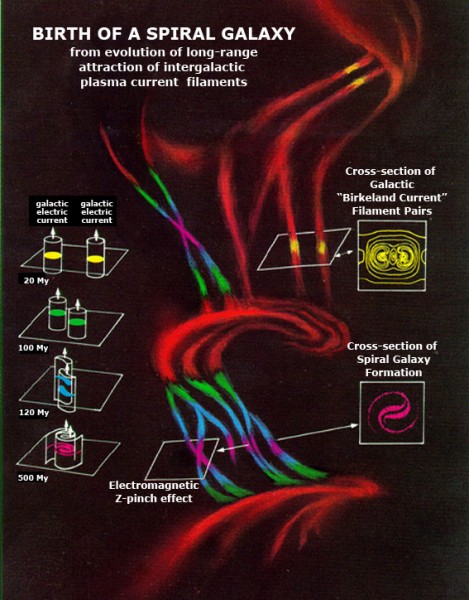
The long-range (1/r) electromagnetic interaction between pairs of intergalactic current filaments, known as “Birkeland currents,” attracts matter from a vast volume of space. Where two filaments intersect, they form a spiral galaxy through the powerful electromagnetic “Z-pinch” effect. This concept has been tested in the lab and by ‘particle-in-cell’ supercomputer simulations. It shows that the extremely weak and limited-range (1/r2) force of gravity has negligible effect in forming a spiral galaxy. It requires no dark matter or MOND!
Formation of the Milky Way galaxy in a cosmic Z-pinch offers a simple explanation for the discovery of satellite galaxies rotating in the same sense in the plane of the Milky Way galaxy.
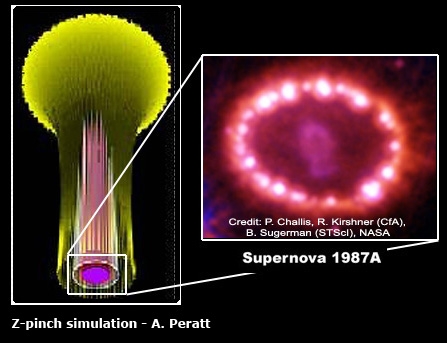
The immense scalability of plasma phenomena allows us to use the dramatic example of the effects of a plasma Z-pinch on a stellar scale in supernova 1987A to explain what happens on a galactic scale. The Milky Way is formed in the central plasma column of the Z-pinch. Surrounding the Milky Way axially are a number of interacting plasma filaments arranged in concentric cylinders that have the potential to produce satellite galaxies. The number of filaments follows a characteristic pattern that suggests they will not be found “in hundreds.” Peratt writes:
“Because the electrical current-carrying filaments are parallel, they attract via the Biot-Savart force law, in pairs but sometimes three. This reduces the 56 filaments over time to 28 filaments, hence the 56 and 28 fold symmetry patterns. In actuality, during the pairing, any number of filaments less than 56 may be recorded as pairing is not synchronized to occur uniformly. However, there are ‘temporarily stable’ (longer state) durations at 42, 35, 28, 14, 7, and 4 filaments. Each pair formation is a vortex that becomes increasingly complex.”
The rotating “vortexes” of the Milky Way and its satellites are driven electrically and will be in the same sense and roughly coplanar.
On a grand scale, the recently discovered evidence for a preferred handedness and axial alignment of spiral galaxies can be explained simply as the result of the general vector of electric current flow in our small corner of an ELECTRIC UNIVERSE® of unknown size and age, remembering that the big bang notions of the size and age of the universe are worthless. The commentary in the MIT Technology Review is revealing:
“..the axis of this alignment points directly towards the mysterious cold spot in the cosmic microwave background, which was discovered in the southern hemisphere in 2004. Nobody knows what caused the cold spot although there are no shortage of ideas. The cold spot could be evidence that our galaxy sits in the middle of a supervoid, a giant empty bubble, say some researchers. Others say it could be the imprint of a parallel universe beyond our own.”
The evidence2 is available that shows the “cosmic microwave background” (CMB) radiation is not “background” at all. It is a local radio “fog” from interacting Birkeland filaments within the Milky Way. The “cold spot” confirms that the “CMB” has no cosmological significance. It is commonsense that one hemisphere will be “colder” than the other, unless we just happen to be dead-center in the electric current stream of our arm of the Milky Way—an unlikely situation. As for the suggestion of a “parallel universe,” it is a meaningless juxtaposition of words—sadly a regular feature of modern physics.
Clearly, the accepted gravitational cosmology of the big bang is hopelessly wrong. Galaxies are not formed by collisions and gravitational accretion. Such a mechanism can only produce random results, which we do not observe. The latest crisis for cosmology comes from relying on unempirical mathematical theorists, whose inappropriate training, dogged use of unsuitable concepts and confused language has led us astray for the entire 20th century. We are overdue for a sensible breakthrough in the 21st!
We are not required to guess or invent new laws. The laws we have are sufficient to understand the Electric Universe—when we truly understand those laws and where and when they apply.
Wal Thornhill
1. Edwin Hubble, The Problem of the Expanding Universe, Science, February 27, 1942.
2. G. Verschuur, On the Critical Ionization Velocity Effect in Interstellar Space and Possible Detection of Related Continuum Emission, IEEE Transactions on Plasma Science, Aug. 2007, Vol. 35, Issue 4, Part 1, pp.759-766.
